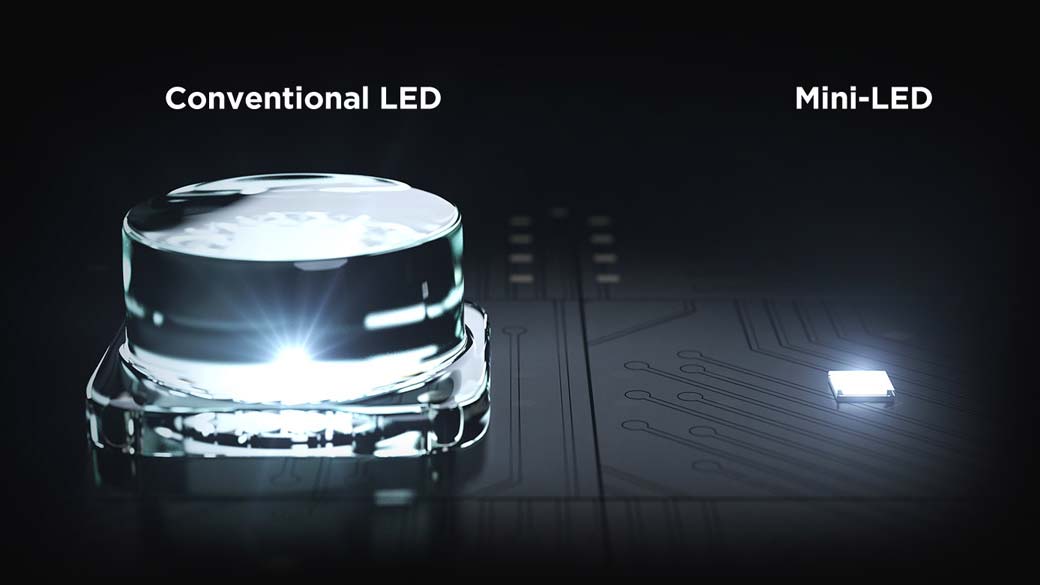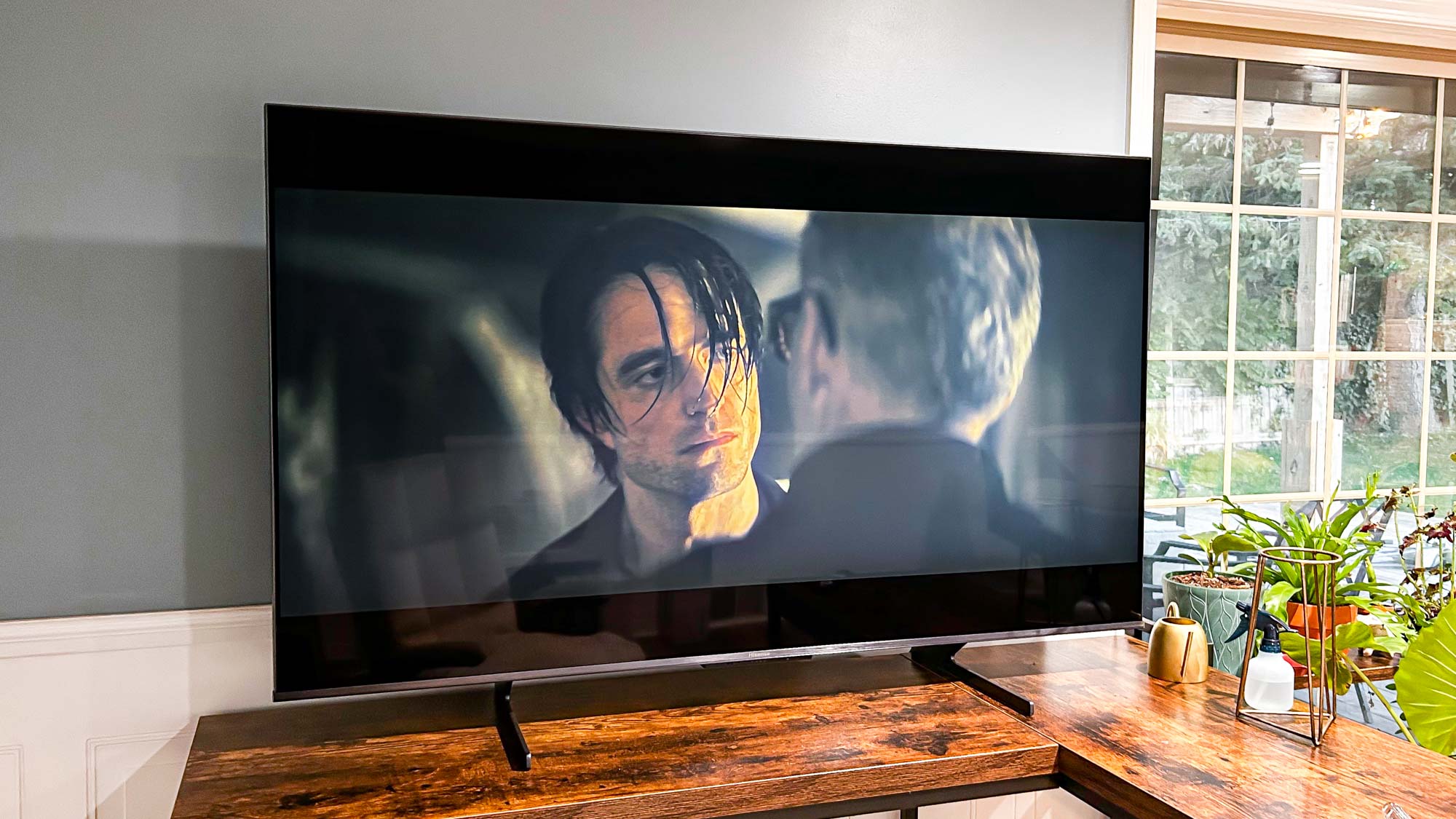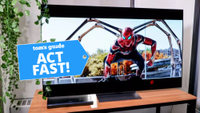
In the quest to find the best TV each year, we end up testing dozens of the top models — including flagship TVs from Samsung, LG, Sony, TCL and Hisense.
As you’d expect, the flagship TVs typically perform the best in these tests and Samsung’s new QN95B QLED performed better than any other TV this year, including the LG C2 OLED, offering superior peak brightness and color accuracy.
I’ll break down the full numbers below, but we saw upwards of 2,000 nits in our SDR brightness tests and a Delta-E score of 1.17 for color accuracy. (The lower the number is the more accurate the colors are on the TV.) These numbers are absolutely phenomenal, and while our full review won’t be ready for a few more days, they bode very well for Samsung’s flagship 4K QLED TV.
The Hisense U8H may not be the better TV overall, but the sheer price-to-performance ratio on offer might give the Samsung QN95B a run for its money.
What was interesting about the results, however, is that there was another TV on our list that came close to these numbers — a TV that costs only about $800 compared to the Samsung QN95B’s steep price tag of $2,099. The TV in question, the Hisense U8H, may not be the better TV overall (I'll tell you why soon) but the sheer price-to-performance ratio on offer might give the Samsung QN95B a run for its money.
Samsung QN95B QLED vs Hisense U8H: test data
| TV Name | Samsung QN85B QLED TV | Hisense U8H ULED TV |
| Price | $2,099 | $799 |
| Peak Brightness (HDR) | 1905.79 nits | 1963.73 nits |
| Delta-E | 1.172 | 3.558 |
| Rec709 Coverage | 99.97% | 99.64% |
| DCI-P3 Coverage | 94.19% | 96.95% |
| Rec2020 Coverage | 74.92% | 79.53% |
| Lag Time (ms) | 9.8ms | 14.6ms |
As I mentioned before, the Samsung QN95B set some new records for our test bench this year for brightness and color accuracy, but was no slouch in lag time (9.8ms) and color saturation, either. We measured color saturation in the Rec 709 Color Gamut, DCI-P3 Color Space and the Rec 2020 Color Space and the QN95B covered 99.97%, 94.19% and 74.92%, respectively. That’s just shy of what the best OLED TV can do for color saturation.
But those are numbers you’d expect from Samsung’s top-end QLED TV. The Hisense U8H, on the other hand, is a mid-range model that delivers similar results…with a few important caveats.
In terms of the hard numbers, the Hisense U8H also hit around 2,000 nits in most modes and scored similarly in the color space tests (99.64%, 96.95% and 79.53%, respectively). It wasn’t as accurate when presenting those colors (it scored a 3.55 on our Delta-E test) and had a much higher lag time of 14.6ms.
Sign up to get the BEST of Tom's Guide direct to your inbox.
Get instant access to breaking news, the hottest reviews, great deals and helpful tips.
TL;DR: The Samsung QN95B, a $2,000 TV, scored just a little better on our tests than the $800 mid-range Hisense U8H. That’s absolutely wild.

Both TVs have a secret weapon: Mini-LEDs
The reason both these TVs are outperforming the competition is because they use a Mini-LED backlight with a large number of local dimming zones.
Mini-LED TVs, for those who've never heard of them before, shrink the size of traditional LEDs to about 1/2 to 1/8th their regular size, allowing manufacturers to pack tens of thousands more into each backlight.
Mini-LED TVs, for those who've never heard of them before, shrink the size of traditional LEDs to about 1/2 to 1/8th their regular size, allowing manufacturers to pack tens of thousands more into each backlight.
Not only can TVs be brighter because of the concentration of Mini-LEDs, but they have better contrast, too.
Add in the quantum dot filter that both TVs use and you'll now see a major uptick in color saturation and accuracy.

Is the Samsung QN95B worth the extra money?
With only the hard data in front of you, it can be hard to justify the cost of the Samsung QN95B — who wouldn’t want the cheaper option when two TVs perform the same?
This is why it’s important to pair test data with real-world observations because the caveat to the Hisense U8H is that, due to differences in their processors, motion processing and upscaling are handled much better on the Samsung. But you’d never know that just by looking at its data points.
Having actually viewed both, there’s no denying that the Neo Quantum Processor 4K in the Samsung QN95B is working a lot harder than the Hisense U8H’s processor. Upscaling leaves little or no noticeable artefacts or fuzz on the Samsung, and motion can be set so that there’s no judder. (You just have to mess around with the settings some.)
There’s a reason why Samsung charges more for its QLED ... Still, if you don't have $2,000 to drop on a new TV, then the Hisense U8H's spectacular specs could make it worth the pickup instead.
The problems I mentioned in our Hisense U8H review are being addressed by the company and should be patched in an upcoming update that will be out by the end of December. We’ll be re-evaluating the TV when this update goes live to the public and will then be able to compare it with the Samsung QN95B once our full review is live.
Our full review is coming soon so I won’t say that you should go one way or the other until it's live — but, having seen both TVs in real-world settings and their incredible test data side-by-side, there’s a reason why Samsung charges more for its QLED.
Still, if you don't have $2,000 to drop on a new TV, then the Hisense U8H's spectacular specs could make it worth the pickup instead.
LG's jaw-dropping G2 OLED TV is $1,000 off in this epic TV deal.

Nick Pino heads up the TV and AV verticals at Tom's Guide and covers everything from OLED TVs to the latest wireless headphones. He was formerly the Senior Editor, TV and AV at TechRadar (Tom's Guide's sister site) and has previously written for GamesRadar, Official Xbox Magazine, PC Gamer and other outlets over the last decade. Not sure which TV you should buy? Drop him an email or tweet him on Twitter and he can help you out.
-
dcaffeine8d Reason for the price difference is sub par components on Hisense. They stop working after 2 years when you no longer have warranty. Parts are also hard to get so you might as well buy a new TV. Samsung I had lasted for 12 years and still going. If TV's were disposable for 2 years then I'd go for Hisense! I wish this factor is mentioned in your tests since consumers are being misled.Reply -
Emo001 Reply
In the article it says you'll be re-evaluating the Hisense U8H once the update goes live (by the end of December) to the public. I'm looking forward to the re-evaluation. Any guesses as to when that new review will be published? Thanksadmin said:The Samsung QN95B Neo QLED TV passed our tests with flying colors — but it has some unexpected competition from the Hisense U8H ULED.
The Samsung QN95B QLED TV aced all of our tests — there's just one problem : Read more

